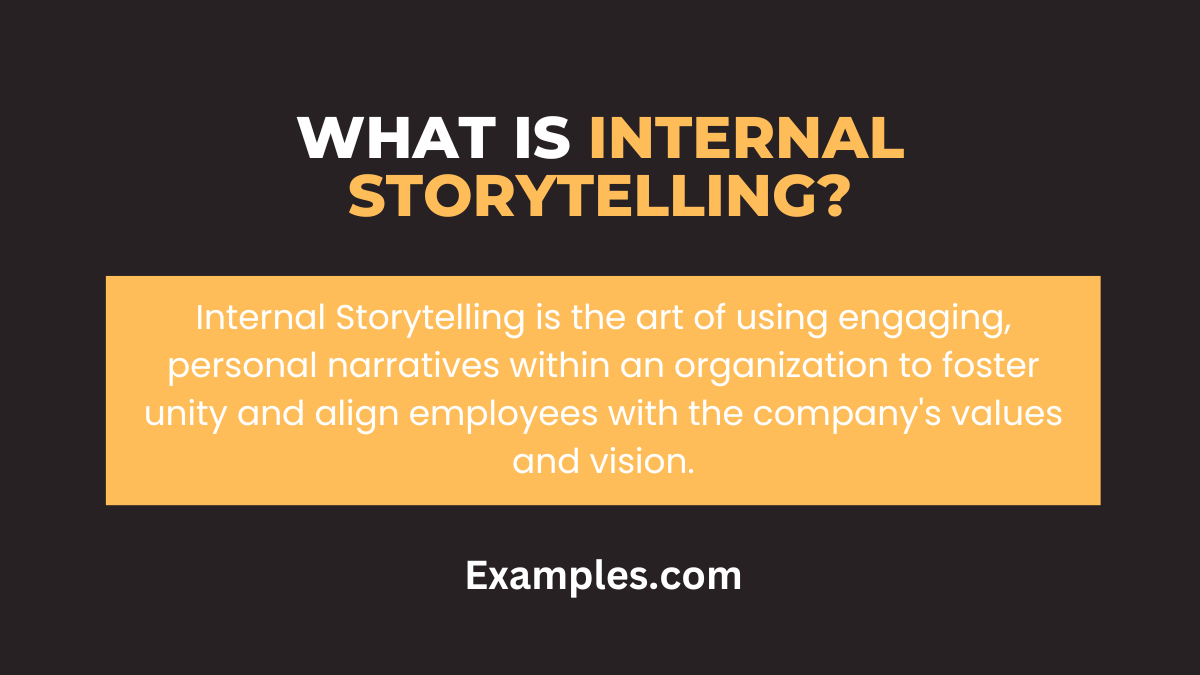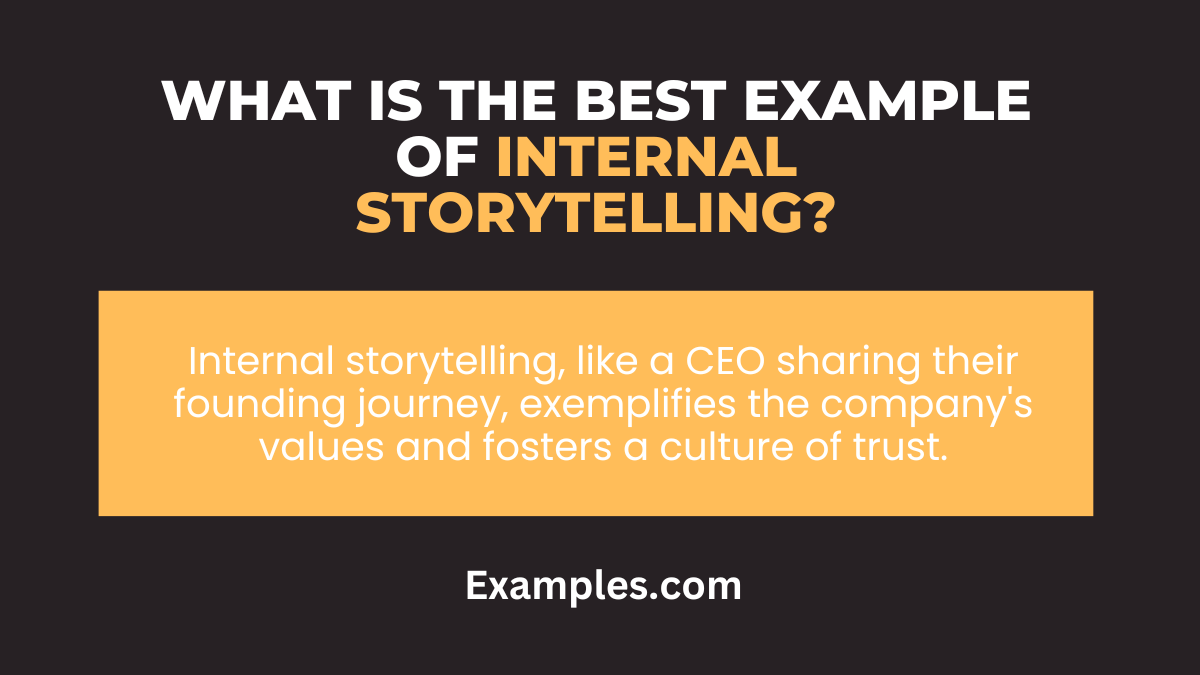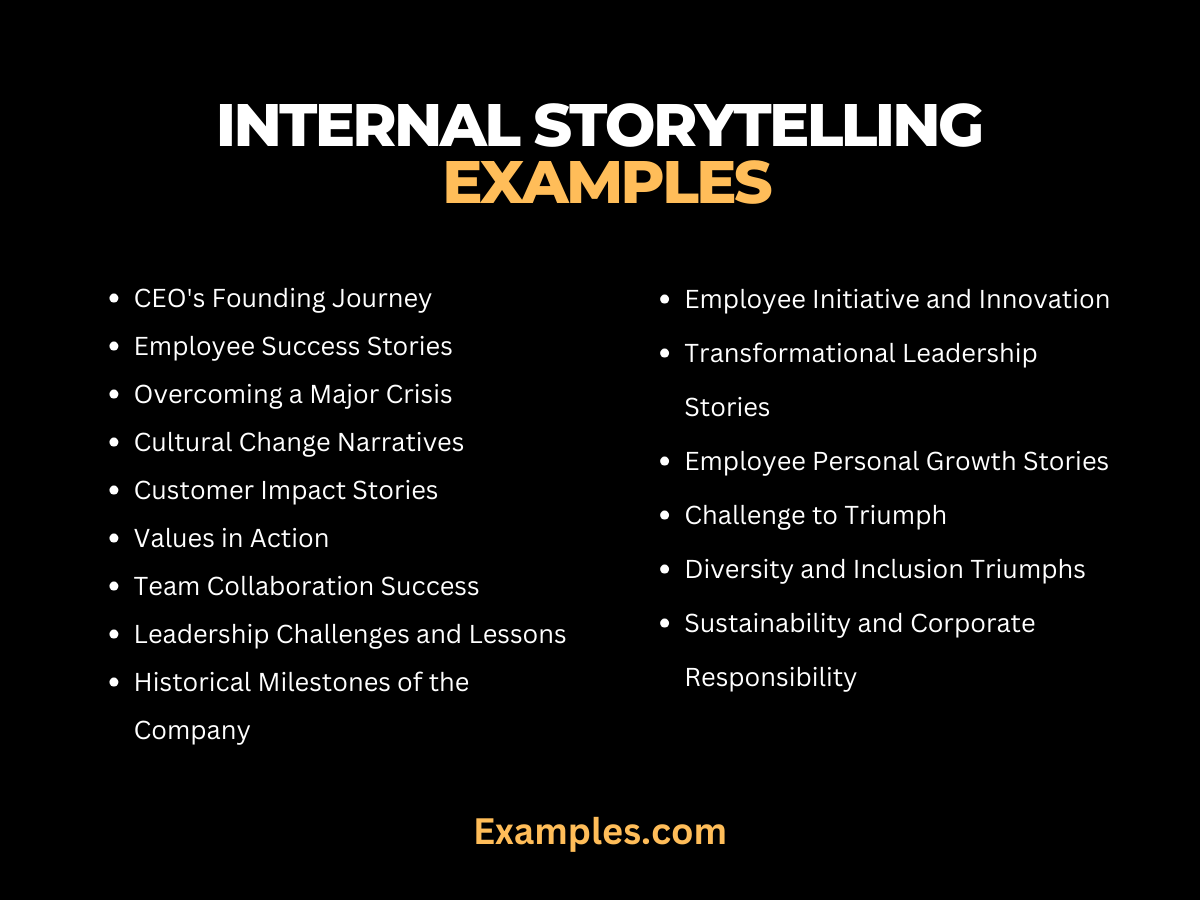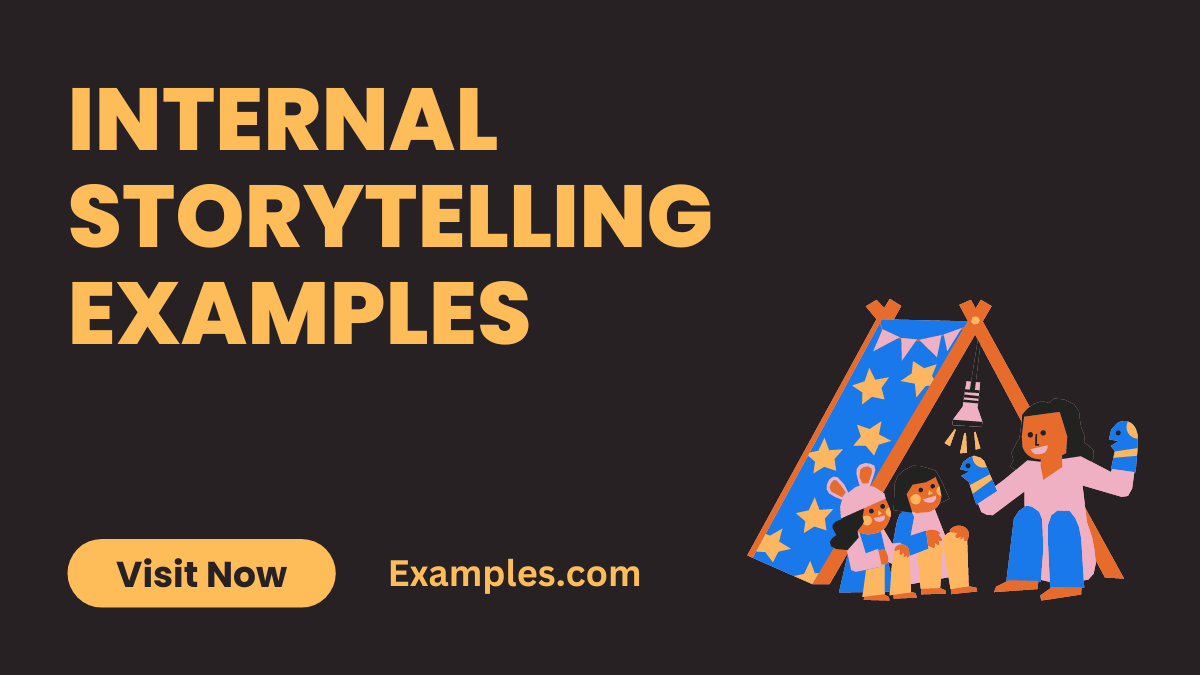14+ Internal Storytelling Examples
Internal Storytelling is a transformative approach that blends creativity with communication to enhance engagement within organizations. This guide dives deep into the world of Internal Storytelling, showcasing its power in fostering a culture of openness and connection. From vivid examples to insightful tips, we illuminate the path for effectively using storytelling to empower, motivate, and inspire teams. Whether it’s for team building, training, or leadership, our compilation of Internal Storytelling examples offers a treasure trove of ideas to bring stories to life in your workplace.
What is Internal Storytelling?

Internal Storytelling refers to the practice of sharing stories within an organization to communicate values, goals, and experiences. Unlike traditional corporate communication, it’s a more personal, engaging way to connect with employees. By weaving narratives that resonate on a human level, Internal Storytelling fosters a sense of belonging and understanding among team members. It’s not just about conveying information but about creating an emotional bond that aligns everyone with the company’s vision and ethos.
What is the Best Example of Internal Storytelling?

The best example of Internal Storytelling often comes from leaders sharing personal experiences that align with the company’s values or objectives. For instance, a CEO recounting their challenges and triumphs in founding the company can be incredibly powerful. This narrative not only humanizes leadership but also serves as an inspirational and relatable story that employees can connect with. It encapsulates the journey, struggles, and successes, making the company’s values and missions more tangible and emotionally impactful for the staff. Such stories not only convey messages but also build a culture of trust and shared purpose.
15 Internal Storytelling Examples

Discover the art of Internal Storytelling with these 15 unique and compelling examples. Each one demonstrates how storytelling can be a powerful tool in building a cohesive and motivated team. From enhancing communication skills to fostering a strong organizational culture, these examples illustrate the dynamic ways in which narratives can be woven into everyday corporate communication. Dive into these scenarios to see how effective communication through storytelling can transform the internal dynamics of any organization.
- CEO’s Founding Journey: The CEO shares their personal journey of founding the company, highlighting challenges and achievements.
- Example: “When I started this company, I faced numerous challenges, but persisting through them has brought us here today.”
- Employee Success Stories: Narratives of employees who have achieved significant milestones, showcasing their growth and company support.
- Example: “John’s journey from intern to manager is a testament to his dedication and our nurturing work environment.”
- Overcoming a Major Crisis: A story about how the company successfully navigated a significant crisis, emphasizing teamwork and resilience.
- Example: “During the financial crisis, our team’s unity and innovative thinking were our biggest assets in overcoming the challenges.”
- Cultural Change Narratives: Stories highlighting the evolution of the company’s culture, focusing on positive changes and adaptations.
- Example: “Our shift towards a more inclusive culture began with small steps, like our ‘Diversity Week’ initiative.”
- Customer Impact Stories: Sharing how the company’s products or services have positively impacted a customer’s life.
- Example: “Our software didn’t just meet ABC Corp’s needs; it transformed their entire workflow, making it more efficient.”
- Values in Action: Stories that demonstrate the company’s core values being practiced in real-life scenarios.
- Example: “When we faced an ethical dilemma with a supplier, choosing integrity over profit reflected our core value of honesty.”
- Team Collaboration Success: A narrative about a project where exceptional team collaboration led to successful outcomes.
- Example: “The marketing campaign was a triumph, thanks to the unparalleled collaboration between our design and sales teams.”
- Leadership Challenges and Lessons: Leaders sharing personal challenges they faced and the lessons learned, promoting transparency.
- Example: “As a leader, admitting my mistake in the XYZ project was tough, but it taught me the importance of accountability.”
- Employee Initiative and Innovation: Stories of employees who took the initiative, leading to innovative solutions or improvements.
- Example: “Anna’s suggestion for a green office not only reduced our costs but also aligned with our sustainability goals.”
- Historical Milestones of the Company: Narratives about key milestones in the company’s history and how they shaped its present.
- Example: “Our first international office wasn’t just a business expansion; it represented our global vision coming to life.”
- Transformational Leadership Stories: Instances where leadership has significantly transformed the company’s direction or strategy.
- Example: “Under our new CEO’s leadership, pivoting towards digital innovation opened new doors for us in the tech industry.”
- Employee Personal Growth Stories: Employees sharing their personal growth journeys within the company, inspiring others.
- Example: “Joining as a junior analyst, I never imagined leading a department, but this company helped me unlock my potential.”
- Challenge to Triumph: Stories of overcoming significant obstacles, emphasizing resilience and determination.
- Example: “Facing the unexpected product recall, our team’s relentless effort turned a challenge into a learning experience.”
- Diversity and Inclusion Triumphs: Celebrating stories of diversity and inclusion, showcasing the company’s commitment to equality.
- Example: “Hiring our first differently-abled team member wasn’t just about diversity; it was about enriching our team’s perspective.”
- Sustainability and Corporate Responsibility: Narratives about the company’s commitment to sustainability and ethical practices.
- Example: “Launching our eco-friendly product line was more than a business decision; it was a step towards our commitment to the planet.”
Internal Storytelling Examples in the Workplace
- Employee Journey to Leadership: An employee narrates their journey from a junior position to a leadership role, inspiring others.
- Example: “Starting as an intern, I never imagined leading the sales team one day. My journey here is a testament to our growth-focused culture.”
- Cross-Departmental Collaboration Success: A story that highlights successful collaboration between different departments.
- Example: “Our IT and Marketing departments worked together on the new app launch, exemplifying our value of teamwork.”
- Innovative Problem-Solving: A narrative about how a team creatively solved a complex problem.
- Example: “Faced with a tight deadline, our team’s innovative approach to the XYZ project led to a breakthrough solution.”
- Mentorship and Career Development: Sharing experiences of mentorship and its impact on personal and professional growth.
- Example: “My mentor here not only guided me through projects but also played a crucial role in my career development.”
- Adapting to Change: Stories about how employees successfully adapted to significant changes within the company.
- Example: “When we switched to remote work, our team’s adaptability and commitment ensured a seamless transition.”
Marketing Internal Storytelling Examples
- Brand Origin Stories: Sharing the story of how the company was founded, emphasizing the passion and values that drove its creation. This approach not only enhances brand loyalty but also makes the communication style more personal and relatable.
- Customer Success Stories: Using customer testimonials and success stories in marketing materials. These narratives showcase the practical benefits of products or services, enhancing communication skills in marketing.
- Behind-the-Scenes Stories: Giving customers a glimpse into the company’s daily operations or product creation processes. This transparency builds trust and showcases the internal communication dynamics.
- Employee Spotlight: Highlighting stories of employees and their contributions to the company. This humanizes the brand and shows the company’s investment in its staff, fostering effective communication.
- Campaign Evolution Stories: Sharing the journey of a marketing campaign from concept to execution. This narrative style helps in illustrating the creative process, engaging customers through storytelling.
Benefits of Internal Storytelling for Employees
- Enhanced Engagement: Stories captivate attention more effectively than standard corporate communication, leading to increased employee engagement.
- Improved Understanding of Company Values: Through storytelling, employees can better grasp and relate to the company’s core values and objectives.
- Stronger Team Cohesion: Sharing personal stories among team members fosters a sense of unity and understanding, strengthening interpersonal communication.
- Increased Motivation: Inspirational stories, especially those highlighting employee achievements and growth, can motivate staff to strive for excellence.
- Better Memory Retention: Employees are more likely to remember information conveyed through stories, thereby enhancing internal communication effectiveness.
Why Should Organizations Use Internal Storytelling?
- Facilitates Better Understanding: Complex ideas or strategies are more easily understood when presented as stories, improving overall internal communication.
- Boosts Employee Engagement: Employees are more likely to feel connected and engaged with their work and the organization when information is shared in a storytelling format.
- Enhances Corporate Culture: Storytelling helps in embedding the company’s values and culture in a way that is both memorable and impactful.
- Improves Knowledge Sharing: Stories can be used to share knowledge and experiences among employees, fostering a learning environment and enhancing communication skills.
- Aids in Change Management: During times of change, storytelling can be an effective way to communicate new directions and strategies, making the transition smoother for employees.
In conclusion, Internal Storytelling is an invaluable tool in today’s corporate landscape, offering a myriad of benefits from enhanced employee communication to stronger team cohesion. This guide has illuminated various aspects and examples of storytelling in the workplace, providing practical tips for effective implementation. Embracing this approach can significantly transform internal dynamics, fostering a more engaged, informed, and motivated workforce.



